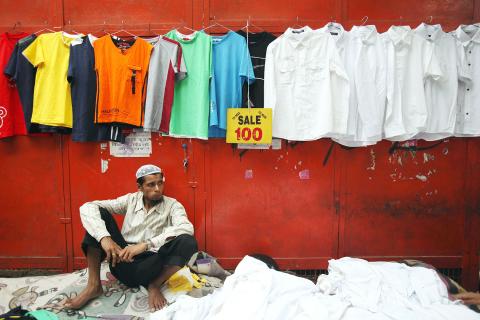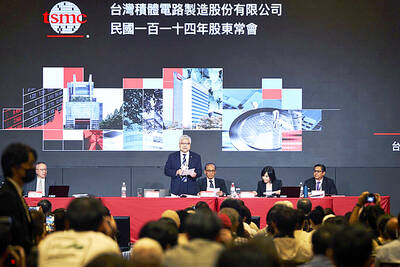Not long ago it was the toast of investors, but India’s appeal has taken a hit, with bearish sentiment building thanks to worries over stubbornly high inflation and widespread political corruption.
Investor ardor for Asia’s third-largest economy has been cooled by a litany of bad news, from slowing growth, rising prices and spiraling interest rates to paralysis on economic reforms and a string of high-profile graft scandals.
Last week, global business information agency Dun and Bradstreet reported that its India business optimism index had fallen by a hefty 22 percent quarter-on-quarter.

Photo: AFP
“There has been a confluence of bad news dragging down sentiment,” Kaushal Sampat, Dun and Bradstreet’s India chief executive, told reporters.
The bad news comes as the government battles multiple corruption scandals that forced the resignation of a second Cabinet minister last week over accusations he abused his power while he held the telecoms portfolio.
“There are so many political fires, it makes it hard for the government to focus on the economic challenges such as reforms needed to spur growth,” Sampat said.
Data for the January to March quarter showed annual economic growth of 7.9 percent — the slowest in five quarters. The key manufacturing sector grew by 5.5 percent, its weakest pace in 18 months.
Quarterly net direct tax collections have fallen 17 percent year-on-year as economic activity decelerates.
Economists blame the downturn on stubbornly high inflation, which the 10 interest rate hikes since March last year have failed to tame. Price pressures are now spreading from food and energy to manufacturing.
“The continual rise in credit costs and high inflation have hurt both investment and consumption,” said Deepak Lalwani, head of London----based India-focused investment consultancy Lalcap.
Factory output has slowed in both India and China, the fastest-growing major global economies, as central bankers have boosted lending rates to fight inflation.
As one sign of waning investor appetite, funds raised through initial public offerings in India slumped by more than 80 percent year-on-year in the first half of the year to US$780 million, according to global data supplier Dealogic.
India’s benchmark Sensex index has already fallen 8.5 percent this year, after rising 17 percent last year, making it one of the worst-performing globally.
The forthcoming quarterly earnings season “will not be a pretty picture,” said Apurva Shah of Mumbai brokerage Prabhudas Lilladher, blaming weakening consumer demand and higher borrowing costs.
The government is expected to officially lower its growth forecast for this year to next year in the coming days from 9 percent to about 8 percent to 8.5 percent — higher than most economists’ expectations.
This week, international ratings agency Fitch cut its growth forecast for India’s economy this year to 7.7 percent from 8.3 percent, citing inflation as a key concern.
While growth of 7 percent to 8 percent would be envied by western economies, experts say India needs at least 10 percent expansion to lift hundreds of millions of Indians out of crushing poverty and the slowdown is seen as unlikely to put an end to rate hikes, with economists predicting further increases in the coming months.
The central bank has made it “crystal clear” it is “prepared to sacrifice some growth in the short term to protect the medium-term prospects of the economy,” said Credit Suisse economist Robert Prior-Wandesforde, who projects 7.5 percent growth this year and next.
Longer-term, economists say India’s so-called “growth story” driven by its vast consumer market and service-led economy is still intact.
However, a lack of economic reforms is hampering progress, and as the government careens from crisis to crisis, it is not expected to pass important pro-market legislation.
Economists have long prescribed reforms such as reducing government control, liberalizing the financial sector, simplifying archaic tax laws and loosening labor-market rules as key to boosting growth, creating jobs and alleviating poverty.
“We are so close [to achieving double-digit growth],” Sampat said. “If we had the right supportive economic ecosystem ... 10 percent growth would not have evaded us.”

With an approval rating of just two percent, Peruvian President Dina Boluarte might be the world’s most unpopular leader, according to pollsters. Protests greeted her rise to power 29 months ago, and have marked her entire term — joined by assorted scandals, investigations, controversies and a surge in gang violence. The 63-year-old is the target of a dozen probes, including for her alleged failure to declare gifts of luxury jewels and watches, a scandal inevitably dubbed “Rolexgate.” She is also under the microscope for a two-week undeclared absence for nose surgery — which she insists was medical, not cosmetic — and is

CAUTIOUS RECOVERY: While the manufacturing sector returned to growth amid the US-China trade truce, firms remain wary as uncertainty clouds the outlook, the CIER said The local manufacturing sector returned to expansion last month, as the official purchasing managers’ index (PMI) rose 2.1 points to 51.0, driven by a temporary easing in US-China trade tensions, the Chung-Hua Institution for Economic Research (CIER, 中華經濟研究院) said yesterday. The PMI gauges the health of the manufacturing industry, with readings above 50 indicating expansion and those below 50 signaling contraction. “Firms are not as pessimistic as they were in April, but they remain far from optimistic,” CIER president Lien Hsien-ming (連賢明) said at a news conference. The full impact of US tariff decisions is unlikely to become clear until later this month

GROWING CONCERN: Some senior Trump administration officials opposed the UAE expansion over fears that another TSMC project could jeopardize its US investment Taiwan Semiconductor Manufacturing Co (TSMC, 台積電) is evaluating building an advanced production facility in the United Arab Emirates (UAE) and has discussed the possibility with officials in US President Donald Trump’s administration, people familiar with the matter said, in a potentially major bet on the Middle East that would only come to fruition with Washington’s approval. The company has had multiple meetings in the past few months with US Special Envoy to the Middle East Steve Witkoff and officials from MGX, an influential investment vehicle overseen by the UAE president’s brother, the people said. The conversations are a continuation of talks that

CHIP DUTIES: TSMC said it voiced its concerns to Washington about tariffs, telling the US commerce department that it wants ‘fair treatment’ to protect its competitiveness Taiwan Semiconductor Manufacturing Co (TSMC, 台積電) yesterday reiterated robust business prospects for this year as strong artificial intelligence (AI) chip demand from Nvidia Corp and other customers would absorb the impacts of US tariffs. “The impact of tariffs would be indirect, as the custom tax is the importers’ responsibility, not the exporters,” TSMC chairman and chief executive officer C.C. Wei (魏哲家) said at the chipmaker’s annual shareholders’ meeting in Hsinchu City. TSMC’s business could be affected if people become reluctant to buy electronics due to inflated prices, Wei said. In addition, the chipmaker has voiced its concern to the US Department of Commerce